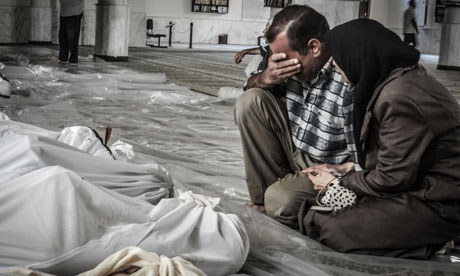A supposed Chemical attack on Syrian civilians occurred on the 21st August which is being deemed by most as a step too far. The Assad regime has come under fire but how and why have they crossed the red line and how are the international community going to deal with it?
The Situation
Chemical weapons are designed to wreak devastation amongst large groups of people. The chemical weapon supposedly used in Syria is Chemical Agent Sarin. It is a colourless and odourless gas which if released can kill and seriously injure a large proportion of people very quickly. Symptoms of chemical weapons are severe and Sarin can cause victims to fall into comas and die if not treated immediately. One of the most recent uses of chemical warfare occurred in the Iran-Iraq war in 1988. Known as the Halabja Massacre, approximately 15,000 civilians were killed or seriously injured by chemical weaponry. However, the damage caused was not only short-term, for years after the attack civilians suffered birth defects and diseases all caused by the chemicals let out during the massacre.
It is for this reason that they have been banned internationally, with only eight countries refusing to agree to the ban. Syria is one of those countries and is known to have stockpiles of the deadly chemicals, making the suggestion that Syria has used them seem probable. A press statement made by ‘medecins sans frontieres’; an unbiased and depoliticised medical charity, further incriminates the Assad regime. The report discloses a recent influx of patients whom are considered victims of chemical weaponry. 3,600 of the charity’s cases displayed the neurotoxic symptoms associated with the Chemical Agent Sarin, 355 of which dying of their injuries after the suspected attack on the 21st of August.
Everyday new evidence is mounting against the Assad regime and the international community is becoming increasingly unsettled. Assad’s potential breach of international law warrants international action but what this should be is difficult to gauge and difficult to agree on.
What is currently being done?
Before now countries, most notably America, have staged discussions over the dire situation in Syria and came to the conclusion that interventions would be made if Syria were to utilise its stocks of chemical weaponry. This was the red line and it has now, almost certainly, been crossed by the Assad regime. As we have seen, most nations oppose chemical weapons because of the large-scale devastation they can cause. However, the international reaction to the events of the 21st of August has been slow and limited because concrete evidence of a standard not yet provided is required for international action to commence. Currently, UN inspectors are heading to the suspected site amid a temporary ceasefire in an attempt to extract such proof and allow the international community to act. However, once proof is obtained the path to action will not be easy. Russia is allied with Assad and has so far blocked all attempts made by the Security Council to effect resolutions to the Syrian problem. Not only this, but America, a key player in international debates, has been burned by previous wars in Iraq and Afghanistan and is keen to avoid another direct conflict in a time of its own financial decline.
Nevertheless, the results of the UN inspection are expected to prove Assad’s use of chemical warfare in Syria and it is therefore unavoidable that international action be taken, be this in the form of air strikes, imposed no fly zones or physical troops on the ground. The red line was drawn to make clear to Syria, and the other seven nations that refuse the ban, that chemical weapons are not welcome and are intolerable. We must therefore act upon our word to make sure Chemical warfare is eradicated and civilians are protected.

